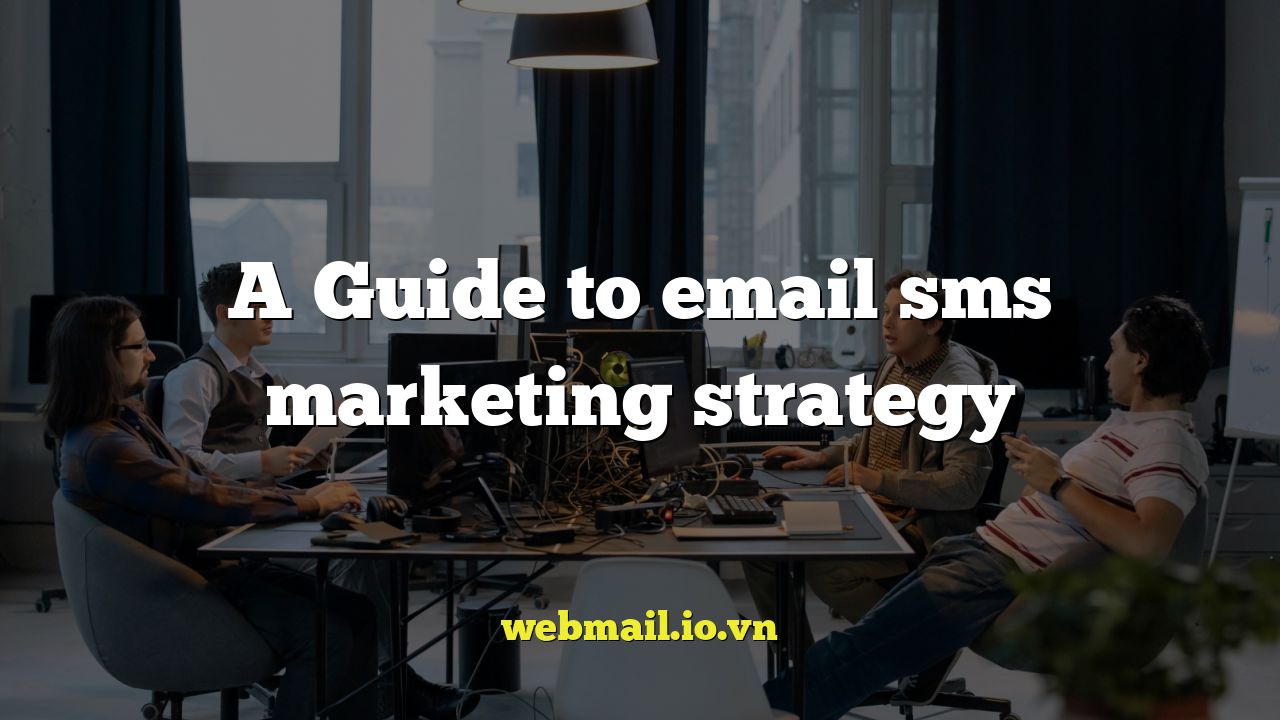
A Comprehensive Guide to Email and SMS Marketing Strategy
In today’s rapidly evolving digital landscape, businesses are constantly seeking effective ways to connect with their customers and drive conversions. Email and SMS marketing, when used strategically in tandem, offer a powerful combination to achieve these goals. This guide will explore the intricacies of crafting a successful email and SMS marketing strategy, covering everything from understanding your audience to measuring your results.
Understanding Your Audience: The Foundation of Success
Before diving into the specifics of email and SMS marketing, it’s crucial to deeply understand your target audience. Without a clear picture of their demographics, preferences, and behaviors, your campaigns are likely to fall flat. Conduct thorough research to identify:
- Age range and gender distribution
- Geographic location
- Interests and hobbies
- Online behavior and preferred communication channels
- Pain points and challenges
Once you have a solid understanding of your audience, you can segment them into smaller groups based on shared characteristics. This allows you to personalize your messaging and tailor your offers to resonate with each segment, leading to higher engagement and conversion rates.
Email Marketing: Nurturing Relationships and Driving Conversions
Email marketing remains a cornerstone of digital marketing, offering a versatile platform for nurturing relationships, building brand loyalty, and driving conversions. Here’s a breakdown of key email marketing strategies:
Building Your Email List
A healthy email list is the lifeblood of any successful email marketing campaign. Focus on acquiring subscribers organically through methods such as:
- Offering valuable lead magnets (e.g., ebooks, checklists, templates) in exchange for email addresses.
- Promoting your email list on your website, social media channels, and in-store.
- Running contests and giveaways that require email registration.
- Providing exclusive content and offers to subscribers.
Remember to always obtain explicit consent before adding someone to your email list. Comply with data privacy regulations like GDPR and CAN-SPAM to maintain trust and avoid legal issues.
Crafting Compelling Email Content
Your email content should be engaging, informative, and relevant to your subscribers’ interests. Consider the following best practices:
- Write clear and concise subject lines that pique curiosity and encourage opens.
- Personalize your emails by addressing subscribers by name and tailoring content to their specific interests.
- Use a consistent brand voice and visual identity.
- Include a clear call to action (CTA) that guides subscribers to take the desired action (e.g., “Shop Now,” “Learn More,” “Download Now”).
- Optimize your emails for mobile devices, as a significant portion of your audience will be reading them on their smartphones.
Email Automation: Streamlining Your Efforts
Email automation allows you to send targeted emails based on specific triggers and behaviors, saving you time and effort while improving engagement. Common email automation workflows include:
- Welcome emails for new subscribers.
- Abandoned cart emails to remind customers about items left in their shopping carts.
- Post-purchase emails to thank customers for their orders and solicit feedback.
- Birthday emails with special offers.
- Re-engagement emails to inactive subscribers.
SMS Marketing: Reaching Customers Instantly
SMS marketing offers a direct and immediate way to reach your customers. With open rates significantly higher than email, SMS can be incredibly effective for time-sensitive promotions, appointment reminders, and urgent updates. However, it’s crucial to use SMS responsibly and avoid overwhelming your subscribers.
Building Your SMS List
Similar to email marketing, you need to obtain explicit consent before sending SMS messages to someone. Common methods for building your SMS list include:
- Offering a valuable incentive (e.g., a discount code or exclusive offer) for signing up for SMS updates.
- Promoting your SMS list on your website, social media channels, and in-store.
- Using a short code or keyword for easy sign-up.
Always provide a clear and easy way for subscribers to opt out of receiving SMS messages.
Crafting Effective SMS Messages
SMS messages are limited to 160 characters, so it’s crucial to be concise and impactful. Here are some tips for crafting effective SMS messages:
- Get straight to the point.
- Use strong verbs and action-oriented language.
- Include a clear call to action.
- Personalize your messages whenever possible.
- Use a URL shortener to save characters.
SMS Automation: Maximizing Efficiency
SMS automation can help you streamline your SMS marketing efforts and deliver timely messages based on specific triggers. Common SMS automation workflows include:
- Welcome messages for new subscribers.
- Appointment reminders.
- Order confirmations and shipping updates.
- Promotional offers based on customer behavior.
Integrating Email and SMS Marketing
The true power of email and SMS marketing lies in their integration. By combining these two channels, you can create a cohesive and engaging customer experience. Here are some ways to integrate email and SMS marketing:
- Use email to nurture leads and build relationships, then use SMS for time-sensitive promotions and urgent updates.
- Send SMS reminders about upcoming email promotions.
- Include SMS opt-in options in your email newsletters.
- Use SMS to collect feedback after an email campaign.
Measuring Your Results and Optimizing Your Strategy
To ensure the success of your email and SMS marketing strategy, it’s essential to track your results and make adjustments as needed. Key metrics to monitor include:
- Email open rates and click-through rates.
- SMS open rates and click-through rates.
- Conversion rates.
- Unsubscribe rates.
- Return on investment (ROI).
By analyzing these metrics, you can identify what’s working and what’s not, and then optimize your campaigns accordingly. A/B testing different subject lines, calls to action, and messaging styles can help you improve your results over time. Regularly review your strategy and adapt it to changing market conditions and customer preferences.
Conclusion
Email and SMS marketing, when implemented strategically, can be a powerful combination for driving engagement, building loyalty, and boosting conversions. By understanding your audience, crafting compelling content, integrating your channels, and continuously optimizing your strategy, you can unlock the full potential of these marketing tools and achieve your business goals.